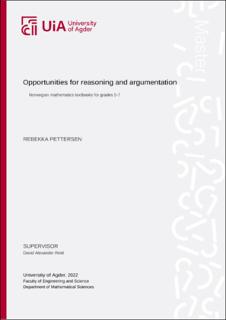| dc.description.abstract | Utdanningsdirektoratet (2019a; 2019b) states that reasoning and argumentation shall permeate the entire mathematics education, and as one of six core elements in the curriculum it is among the most important contents in mathematics education. Reasoning and argumentation in mathematics is about understanding that mathematical rules and results have obvious reasons and are not random, and to give reasons and prove that approaches, reasons, and solutions are valid (Kunnskapsdepartementet, 2019a). Several researchers refer to textbooks as central in teaching, both in planning and completing lessons (Wong & Sutherland, 2018; Pepin et al. 2013). The goal of the present study is to understand what opportunities there are for reasoning and argumentation in Norwegian mathematics textbooks for grades 5-7, and the research questions are: 1) To what extent do Norwegian mathematics textbooks use words related to reasoning and argumentation?; and 2) How are the words related to reasoning and argumentation used in the textbooks, and what usages offer opportunities for reasoning and argumentation? Reasoning and argumentation as defined in the curriculum must be deductive, and proof is included as a central part of the core element Reasoning and argumentation (Valenta & Enge, 2020). Proof is defined by Stylianides (2007) as a mathematical argument for or against a mathematical claim expressed by statements, forms of reasoning, and forms of representations that are known to a classroom community. I have in this study used the method of Document analysis, consisting of a superficial examination of the textbooks to examine the extent of the words related to reasoning and argumentation, followed by a closer analysis. I have adapted the aspects structure, language, and function as defined by Miyakawa and Shinno (2021) in the closer analysis, to examine the usage of the words related to reasoning and argumentation, and to consider what usages offer opportunities for reasoning and argumentation. The findings of the superficial examination show that the words occur rarely or not at all in the textbooks analyzed. The words resonnere and bevise do not occur, argumentere occurs 9 times, begrunne occurs 169 times, forklare occurs 271 times, and vise occurs 609 times in the 15 analyzed textbooks. Several usages are found not to offer opportunities for reasoning and argumentation, but some usages are found to offer such opportunities. The textbooks do offer opportunities for reasoning and argumentation; however, the overall understanding of such opportunities is that they are few, which contrasts both with the curriculum and the call from mathematics educational researchers for reasoning and argumentation to be a central part of mathematics education. This study could be beneficial for understanding what opportunities there are for reasoning and argumentation in Norwegian mathematics textbooks and for understanding the difficulties teachers and pupils might face when searching for opportunities to teach, guide, support, learn and understand reasoning and argumentation in mathematics. | |
